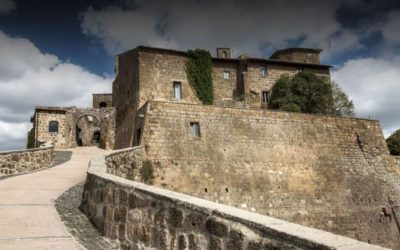 di redazione – I prossimi 13, 21 e 25 giugno, dopo l’esordio di ieri 6 giugno, sarà possibile osservare il passaggio del sole nello gnomone del Duomo di Firenze. Uno spettacolo da non perdere anche perchè con i suoi 90 metri di altezza è il più grande al mondo
di redazione – I prossimi 13, 21 e 25 giugno, dopo l’esordio di ieri 6 giugno, sarà possibile osservare il passaggio del sole nello gnomone del Duomo di Firenze. Uno spettacolo da non perdere anche perchè con i suoi 90 metri di altezza è il più grande al mondo
Anche quest’anno sarà possibile assistere all’emozionante passaggio del sole nello gnomone del Duomo di Firenze. Uno spettacolo unico al mondo, con i raggi del sole che scenderanno attraverso la Cupola del Brunelleschi per formare un’immagine del disco solare che andrà a sovrapporsi perfettamente a quella posta sul pavimento del Duomo.
Il fenomeno sarà visibile al pubblico nei giorni 13, 21 e 25 giugno, dalle ore 12.30 alle 13.30, nella cappella della Croce, a sinistra dell’Altare Maggiore. L’iniziativa, resa possibile dall’Opera di Santa Maria del Fiore con il Comitato per la Divulgazione dell’Astronomia, si svolgerà anche in caso di cielo coperto, ed è a ingresso gratuito con accesso dalla porta dei Canonici (davanti a via della Canonica). E’ consigliata la prenotazione telefonando al numero telefonico 055-2302885.
E’ dal 1475 che questo fenomeno si ripete nel Duomo di Firenze, grazie ad uno strumento astronomico, il più antico e diffuso al mondo, lo gnomone, dal greco “indicatore”, progettato per misurare la posizione del Sole in cielo e determinare la durata dell’anno solare.
Fatto installare nella Cattedrale presumibilmente dal matematico fiorentino Paolo Dal Pozzo Toscanelli, utilizzato a vicende alterne per oltre 300 anni, lo gnomone del Duomo di Firenze, con i suoi 90 metri di altezza, è il più grande al mondo.
Uno gnomone così grande poteva servire anche per un’indagine più ambiziosa e cioè quella determinare la variazione dell’inclinazione dell’asse di rotazione della Terra sul piano dell’orbita, dato fondamentale per il calcolo delle effemeridi solari. L’inclinazione della Terra, infatti, non è costante ed era una questione era già discussa dagli astronomi arabi.
Nella Cattedrale di Firenze il foro gnomonico è stato realizzato con una tavoletta di bronzo (la bronzina) recante un’apertura centrale di un paio di centimetri di diametro e posta orizzontalmente all’interno della finestra meridionale del tamburo della Cupola, a 90 metri di altezza dal pavimento.
L’altezza dello gnomone è tale che i raggi del Sole, passanti per il foro, colpiscono il pavimento della chiesa solo dalla fine di maggio alla fine di luglio e per pochi minuti prima e dopo mezzogiorno.
In questo periodo l’immagine solare si forma sul pavimento della Cappella della Croce, a sinistra dell’Altare maggiore, dove si trovano, sotto la protezione di lastre di ottone, una linea meridiana finemente graduata e due marmi circolari, uno dentro l’altro, che funzionano da contrassegni solstiziali. Il maggiore, con un diametro di circa 90 centimetri, ha le stesse dimensioni dell’immagine solare al solstizio d’estate.
http://operaduomo.firenze.it/
 by redaction – The next 13, 21 and 25 June, after the onset of yesterday June 6, will be able to observe the passage of the sun in the gnomon of the Duomo of Florence. A show not to be missed because even with its 90 meters is the largest in the world
by redaction – The next 13, 21 and 25 June, after the onset of yesterday June 6, will be able to observe the passage of the sun in the gnomon of the Duomo of Florence. A show not to be missed because even with its 90 meters is the largest in the world
Also this year you can watch the thrilling passage of the sun in the gnomon of the Duomo of Florence. A unique show in the world, with the rays of the sun coming down through the Brunelleschi’s Dome to form an image of the solar disk that will overlap perfectly to the post on the floor of the Cathedral.
The phenomenon will be visible to the public on days 13, 21 and 25 June, from 12.30 to 13.30, in the Chapel of the Cross, to the left of the High Altar. The initiative, made possible by the Opera di Santa Maria del Fiore with the Committee for the Popularization of Astronomy, will take place even if the sky is overcast, and it is free admission with access from the door of the Canons (in front of the rectory via ). And ‘reservations are recommended by calling the telephone number 055-2302885.
And ‘from 1475 that this phenomenon is repeated in the cathedral of Florence, thanks to an astronomical instrument, the oldest and most widespread in the world, the gnomon, from the greek “indicator”, designed to measure the position of the Sun in the sky and the duration the calendar year.
Had installed in the Cathedral presumably by the Florentine mathematician Paolo Dal Pozzo Toscanelli, used to ups and downs for over 300 years, the gnomon of the Duomo of Florence, with its 90 meters high, is the largest in the world.
One could also serve as great gnomon for a more ambitious, namely that determine the variation of the inclination of the axis of rotation of the Earth on the plane of the orbit, as fundamental for the calculation of solar ephemeris. The tilt of the Earth, in fact, is not constant and it was an issue was already discussed by Arab astronomers.
In the Cathedral of Florence, the gnomonic hole was made with a bronze tablet (the bush) containing a central opening of a few centimeters in diameter and placed horizontally in the south window of the drum of the dome, 90 meters in height from the floor.
The height of the gnomon is such that the rays of the sun, passing through the hole, hit the floor of the church only from late May to late July and for a few minutes before and after noon.
In this period the solar image is formed on the floor of the Chapel of the Cross, to the left of the altar majeure, where they are, under the protection of brass plates, a meridian line finely graded circular and two marbles, one inside the other , which work by solstice marks. The largest, with a diameter of about 90 centimeters, has the same size as the sun at the summer solstice.
http://operaduomo.firenze.it/



0 commenti